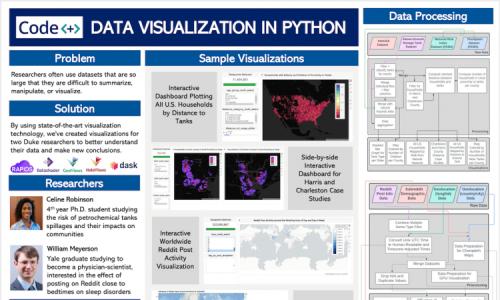
Visualizing Hidden Risks
How a Ph.D. student leveraged the Code+ summer program for her dissertation and beyond
Deep in the heart of Gross Hall, a group of determined undergraduate students huddled around glowing computer screens, their fingers dancing across keyboards as they raced against the clock to uncover crucial information hidden within vast sets of data. This Code+ team was on a mission.
Through Duke’s Code+ summer program, students work in small teams with industry professionals and project stakeholders, involving themselves in the immersive end-to-end development of projects. For undergraduates, it’s an opportunity to hone their skills in a setting beyond the classroom.
The program’s value also extends to graduate students. Celine Robinson, a Ph.D. student in civil and environmental engineering, utilized Code+ to enhance her doctoral dissertation while also mentoring the undergraduates.
“My entire dissertation is based on a Bass Connections project,” said Robinson. She’s examining the intersection of critical infrastructure failure and natural hazards, such as hurricane-induced ground storage tank failures. With an EPA STAR grant, she is building on that research by exploring the environmental and human health impacts of such failures on nearby communities.
A large part of her research involved looking at data on industrial livestock facilities in the U.S. that produce vast amounts of animal waste. For the past two years, Robinson said that she has “been working with some really amazing undergraduates to build out a dataset” to analyze. While this data is regulated and easily accessible, Robinson emphasized that “it can be very difficult to conceptualize what the data looks like” in order to conduct analyses into the impacts on the communities around these large farms and tanks.
That’s where Code+ came in handy. Katie Kilroy, director of research computing in the Office of Information Technology, presented Code+ to Robinson as an opportunity to be a stakeholder in a data visualization project. “I jumped on it,” said Robinson, “because it really fed into my project in a way that I was looking for.” Additionally, she was excited by the opportunity to connect with undergraduates.
The Code+ team, Visualization in Python for Duke Data Scientists, focused on the communication of large-scale datasets — like Robinson’s 150,000-object infrastructure dataset — through visualizations.
“I really enjoyed working with them,” Robinson said of the undergraduates. “I think we both got something out of it. Their final project was going to be something that was useful for my dissertation and our work with the [EPA STAR] grant. And they acquired transferable skills that were going to be useful to them, and they got to deliver to a client — that in itself is a valuable skill.”

Throughout the 10-week program, Robinson took great care to enhance the learning and involvement of the undergraduates at every step.
“We had a general idea of what we needed,” she said, meaning visualizations of the dataset. “But I wanted to ensure that all the students had some ownership of what they were doing and that allowed them to take it a bit further. They had different experiences and skill sets, but their ownership and interest in the project is the thing that makes it work.”
With an overarching goal in mind and the autonomy to explore, the team’s final product went above and beyond what Robinson had in mind.
The students developed a mapping application that can display and share crucial information with community partners. “We’re primarily interested in the tanks that contain petrochemicals or crude oil products,” Robinson explained. “The mapping application creates a risk index for each of the tanks, basically looking at the vulnerability of the tanks to different natural hazards. You could type in an address, see what tanks are nearby and see those tanks’ risks of failure.”
Robinson thinks that “this project will add onto the work we’re doing with our current grant. We’re 100 percent using the visualizations that were produced,” Robinson emphasized. “The Git repository [the students] developed was beautiful, truly one of the best documented things I’ve ever seen. And I’m hoping they’ll continue working on the mapping application.”
After finishing her doctorate, Robinson hopes to use the broad set of skills she’s developed, as opposed to focusing solely on the context of her research. “Some of the jobs I’m looking at are around climate risks more broadly,” she noted. “Some of them are research scientist positions that are centered on large-scale data problems.”
Regardless of where her postgraduate endeavors take her, Robinson’s Code+ experience has made a lasting impact. “My preference is to continue investing in people,” she explained. “Everyone should do Code+. It’s great!”
Lily Neusaenger ’25 is a content writer in the Office of the Provost. She is majoring in computer science with minors in statistical science and creative writing.